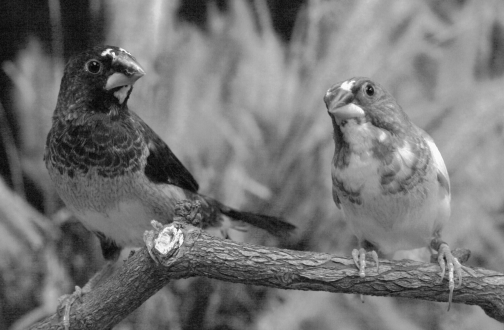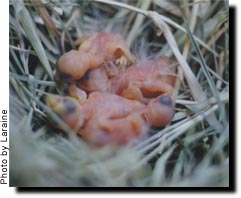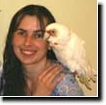


Over the years that I have been breeding Gouldians, I have found that some young Gouldians can be undependable as parents. They will lay eggs but not sit or they will abandon the eggs after several days. The most frustrating behavior I have observed is when they throw the young babies from the nest. Nothing is more disheartening, especially to someone new to Gouldians than to lose nestlings from this behavior. Whenever this subject comes up, it seems that the first solution offered is to keep Society Finches to foster the pitched babies or abandoned eggs. While it is true that Society Finches will most often solve this immediate problem because most of them will readily accept the Gouldian eggs or nestlings as their own, I would like to suggest that this is NOT the best solution to this problem.
In other articles throughout this website we will discuss ways to allow your Gouldian parents to raise their own babies. In this article, I will relate my experiences with Society Finches and explain the pros and cons of using them.
"Carriers" of several diseases
However...…using Society Finches as foster parents for Gouldian chicks is not without problems. While it is true that they have been bred over the years to be excellent parents, all Society Finches can become "carriers" of several diseases that will not affect them or their own offspring but could prove lethal to species of birds that have evolved in dry, arid conditions. The 2 most common "wet" diseases which Society Finches can carry, that will affect Gouldian chicks are Campylobacter and Cochlosoma.
Let me say plainly here, that NOT ALL SOCIETY FINCHES ARE CARRIERS OF CAMPYLOBACTER AND COCHLOSOMA, but once a Society Finch has been exposed to and become infected with either of these diseases, they cannot be "cured". This is known as being a "carrier." The disease will just remain in their body, ready to infect any species that has not developed immunity against it. Gouldian Finches fall into the category of a dry land species that will be negatively affected by Campylobacter and Cochlosoma. Your avian vet can perform tests to see if your Society Finches are carrying either of these diseases.
I have found that while both diseases can be "kept in remi ssion" during a breeding season to allow infected Society Finches to foster Gouldian chicks, I would not recommend doing it. By constantly medicating the Society Finches, you are also medicating the chicks. This constant medication does not allow the chicks to develop their own strong immune system and, therefore, the chicks produced will always be weak. I realize that this may put you between a rock and a hard place, should your Gouldian parents reject their chicks, but do we want to save them at the expense of their overall health for a lifetime? Also, many of the chicks that do survive will become carriers themselves and will then pass on this condition or passively kill their own chicks when they breed in later years.
ssion" during a breeding season to allow infected Society Finches to foster Gouldian chicks, I would not recommend doing it. By constantly medicating the Society Finches, you are also medicating the chicks. This constant medication does not allow the chicks to develop their own strong immune system and, therefore, the chicks produced will always be weak. I realize that this may put you between a rock and a hard place, should your Gouldian parents reject their chicks, but do we want to save them at the expense of their overall health for a lifetime? Also, many of the chicks that do survive will become carriers themselves and will then pass on this condition or passively kill their own chicks when they breed in later years.
So if you are intent to use foster Society Finches to raise your Gouldian chicks, I would have the droppings of all of your Society pairs tested by an avian vet to be sure that they are not infected with either Cochlosoma or Campylobacter before any breeding takes place.
Campylobacter treatment
The medication recommended to me many years ago to subdue Campylobacter is Erythromycin. This drug can only be given to the Society Finches before the eggs hatch because the medication will have adverse effects on the growing chicks. You will have to hope that the disease does not surface again until the chicks are weaned and independent (7 weeks). You would then medicate the Society Finches again during the next incubation go round, if they are to foster another clutch of Gouldian chicks.
While Erythromycin is the drug of choice, if Erythromycin is not available, it is my understanding that both Tetracycline and Doxycycline can also be used to treat the Campylobacter. But neither of these drugs is recommended for young chicks, so the same treatment schedule should be used as mentioned above for the Erythromycin.
Cochlosoma treatment
The drug of choice for Cochlosoma is Ronidazole. While this drug is safe for chicks because it will not hinder their development, it will subdue development of their immune system. It will be necessary to treat with Ronidazole every other week for the entire time the chicks are being fed, until they become independent and eating on their own and can be removed from their parents.
With this information in mind, I have found that Society Finches (a cock and hen pair) do need to be in the "breeding mode" before they will successfully raise chicks. Not only do they need to be laying their own eggs, but the egg laying needs to be synchronized with your Gouldian egg laying. In other words, you can’t take about to hatch eggs from a pair of Gouldians and give them to a pair of Society Finches that just started laying their own clutch. Birds do have a sense of timing and could abandon eggs that hatch right after they get down to incubating their own newly laid eggs.
If you are using a trio of cocks or several hens the synchronization isn’t as critical. To see if they are receptive to incubating eggs, you can give them infertile eggs from a previous clutch of eggs, or you can even test them with the small plastic finch eggs. Just remember that in my experience, even if they begin incubating the eggs, they may not feed or care for the hatched babies if they are too young (not sexually mature.) And, contrary to popular belief, not every Society Finch will be a good parent. The European Society Finches are reluctant breeders themselves, so they do not make good foster parents. Almost all of the American and Japanese Society Finches will foster other species successfully.
Breeders differ on foster pairing
Society Finches that are laying their own eggs will usually accept both eggs and just hatched live babies from another pair of birds. However, I have found that they are more likely to do this if they have been allowed to raise a clutch of their own babies first. This was not the information I received when getting started with fostering. Most breeders believe that you should never allow Society Finches to raise their own babies first, as this will predispose them to rejecting chicks of other species. For instance, Gouldian chicks have distinct mouth markings along the edge of their mouths to facilitate the feeding parents in the darkened cavities where they breed in the wild. Society chicks do not have these markings. But my experience has not been the rejection of Gouldian chicks after Society Finches have raised a clutch of their own.
Society Finches can be paired as foster parents in the following way:
* 1 cock and 1 hen
* 2 hens
* 3 cocks
Best results
The second two scenarios will usually result in better success since same sex pairings will not want to start a second clutch before the first clutch is independent. This is important when using Society Finches as foster parents because Society Finches do not feed their own chicks as long as Gouldian parents would feed theirs. So if a cock and hen pairing begin breeding again before the chicks are ready to be on their own, they can sometimes neglect the first clutch of chicks before the chicks are ready to be on their own. Even though Gouldian chicks may not get as much food while being fed by Society parents, they will make up for lost time once they start eating on their own. So while they may be smaller in stature upon weaning, they will be about matched to chicks raised by Gouldian parents by 3-4 months of age.
Airsac mites
I have read several articles that state if you want to stop the transfer of airsac mites to the Gouldian babies, use the Society Finch to foster. The articles always say that Society Finches do not become infested with the air-sac mite. In my experience I do not find this to be true. Society Finches living in close proximity to Gouldian Finches that are infested with air-sac mites will also get air-sac mites and should be treated the same as Gouldians with S76 or SCATT.
Imprinting
When Society Finches are used to foster chicks from any other avian species, it is important to remove the chicks from the Society parents as soon as possible once they are weaned and eating on their own so that they do not "imprint" on the Society Finches and later in life reject pairing with other Gouldians.





